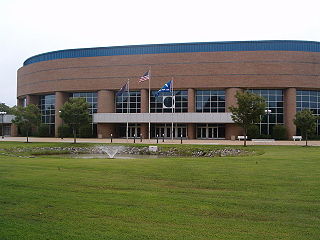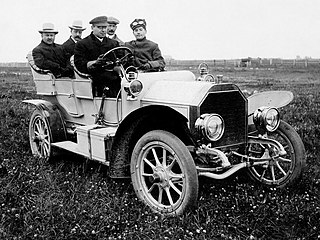
The Ford Model C is an automobile that was produced by Ford Motor Company. Introduced in late 1904, the Model C was Ford's lower priced 1905 model. The first sales were in October 1904, with most sold during the 1905 calendar year. Horace Dodge made major changes to the design of the engine, rear axle and other parts of the car. The Model C used the same 10 hp motor the 1904 Model A was equipped with. Model C had a longer wheelbase than the earlier Model A. Built at the Ford Piquette Avenue Plant, it was the entry-level car in the Ford model lineup, slotting below the upscale Model B. Production ended in 1905 with approximately 1,000 cars produced. About 160-170 Model C were assembled in Canada at Ford's new Ford Canada location in Walkerville. Due to the Dodge Brothers owning a ten percent share of the company, as well as supplying many parts and assemblies, the Model C took to the road with Dodge-built engines and other key assemblies.

Viking was a brand of automobiles manufactured by General Motors as a supplement to Oldsmobile division for model years 1929 to 1931 and used the GM B platform. It was shared with the Oakland Model 301 for 1930 and 1931.
The Trinity Health Arena is a 3,000-seat multi-purpose arena in Muskegon, Michigan, United States. It was built in 1960 in partnership with philanthropist and industrialist Louis Carlisle Walker at a cost of $2 million, and on October 27, 1960, was formally gifted to the City of Muskegon. Mr. Walker provided $1 million and the City provided $1 million toward the cost. It is currently home to the Muskegon Lumberjacks of the United States Hockey League, Muskegon Risers SC of Major Arena Soccer League 2, and the West Michigan Ironmen indoor football team. The Arena will change its name to Trinity Health Arena after a corporate decision to rename Mercy Health facilities Trinity Health.

Publix Field at Joker Marchant Stadium is a baseball field in Lakeland, Florida. The 8,500-seat stadium was opened in 1966 and has had multiple renovations, most recently in 2017. It was named after local resident and former Lakeland Parks and Recreation Director Marcus "Joker" Marchant. It is the spring training home of the Detroit Tigers and the regular-season home of the minor league affiliates Lakeland Flying Tigers and Gulf Coast Tigers.

OU Credit Union O'rena is a 4,000-seat multi-purpose arena in Auburn Hills, Michigan with a Rochester mailing address. It is home to the Oakland University Golden Grizzlies men's basketball, women's basketball and volleyball teams. The court has a distinctive "blacktop" color first used in the 2015–16 season.

Hampton Convocation Center is a 7,200-seat multi-purpose arena in Hampton, Virginia. It was built in 1993 and is home to the Hampton University Pirates basketball team. The arena replaced Holland Hall gymnasium, which holds women's volleyball matches and tournaments. The construction cost was about $4 million-$5 million.

The Packard Station Sedan was a luxury station wagon model produced by the Packard Motor Car Company of Detroit, Michigan between 1948 and 1950, using the reintroduced Packard Eight platform. By offering the Station Sedan Packard could market a vehicle with station wagon attributes, but without the investment cost associated with a complete station wagon development program.

The Packard Eighteenth Series One-Ten was a range of six-cylinder automobiles produced by the Packard Motor Car Company of Detroit, Michigan during the 1940 and 1941 model years. The One-Ten designation was renamed from the previous Packard Fifteenth Series Six (115-C).The One-Ten shared the wheelbase of the One-Twenty but was given the One-Ten designation to indicate it was the entry level product.

The original Ford Model A is the first car produced by the Ford Motor Company, beginning production in 1903. Ernest Pfennig, a Chicago dentist, became the first owner of a Model A on July 23, 1903; 1,750 cars were made in 1903 and 1904 at the Ford Mack Avenue Plant, a modest rented wood-frame building on Detroit's East Side, and Ford's first facility. The Model A was replaced by the Ford Model C during 1904 with some sales overlap.
DeVos Fieldhouse is a 3,400-seat indoor arena in Holland, Michigan. It was built in 2005, at a cost of $22 million. It is home to Hope College's men's and women's basketball teams, the Hope Flying Dutchmen and the Hope Flying Dutch and Hope College's volleyball team.
The Packard Pan-American is a concept car produced for the Packard Motor Car Company of Detroit, Michigan in 1952.

The Cheshire Bridge spans the Connecticut River between Charlestown, New Hampshire and Springfield, Vermont.

The Packard Pacific is an automobile manufactured by the Packard Motor Car Company of Detroit, Michigan for the 1954 model year. It replaced the Mayfair and was sold exclusively as a two-door hardtop.

The Mercury Medalist is an automobile which was produced by Mercury for the 1956 model year and was similar to the Ford Customline in market segment.

The Mercury Custom is an automobile which was produced by Mercury for the 1952 through 1956 model years.
Sears Dreadnought was a motorcycle sold by Sears in the 1910s. The motorcycle featured a 70.62-cubic-inch (1,157.3 cm3) V-twin made by Spacke. It was sourced from Spacke's cyclecar and had 9 horsepower (6.7 kW). This engine was also used by Dayton, Eagle, Minneapolis and Crawford. In addition to the internal combustion engine, it also had foot-pedals like a regular bicycle.

The Model S was the first four-seat passenger car produced by Oldsmobile in 1906, offered as a larger alternative to the Model R Curved Dash runabout that appeared in 1901. The advertised price was $2,250. It was Oldsmobile's first four cylinder car and took the top level marketing position above the Model L and the entry-level Model R. It was one of the last independently developed products before they joined General Motors in 1908, and competed against Buick, Ford and other automakers at the time. It was built at the Oldsmobile factory in Detroit and developed by Frederick and Angus Smith, whose father Samuel L. Smith was the primary investor, and R. E. Olds had left the company due to an argument with Oldsmobile Board of Directors.
The Model 42 was an entry-level four seat passenger car produced by GM's Oldsmobile Division in 1914. It was offered as a replacement to the Oldsmobile Curved Dash runabout when it was discontinued in 1908, and was the junior platform to the Oldsmobile Six introduced in 1913. GM had acquired Elmore Manufacturing Company, Oldsmobile and Oakland Motor Car Company in 1908 and Cartercar and Rainier Motor Car Company in 1909 as their entry-level models, and Oldsmobile products were being repositioned in their new hierarchy as GM began to consolidate operations after William Durant had left.

The Oldsmobile Six, also known as the Model 53, 54 and 55 (1913-1915) then a brief cancellation until it reappeared as the Model 37, 37A and 37B (1917-1921) was a top level sedan along with the Oldsmobile Series 40 junior vehicle produced by GM's Oldsmobile Division and was manufactured at Lansing Car Assembly in Lansing, Michigan. It replaced the Series 28 also known as the "Oldsmobile Autocrat" and was replaced by the Oldsmobile Model 30 in 1927, and shared wheelbases with the Buick Six. It continued to use the T-head engine for two years. The various bodystyles were supplied by Fisher Body of Detroit, MI. It competed with the Chevrolet Series C Classic Six as Chevrolet was an independent company before becoming a division in 1917. Oldsmobile also shared technology with GMC for commercial and industrial products.
The Oldsmobile Series 28, also known as the Autocrat, was a mid-level four seat passenger car produced by GM's Oldsmobile Division for 1911 and 1912. It was based on the top-level Oldsmobile Limited while using a four-cylinder engine, and was manufactured in Lansing, Michigan.














